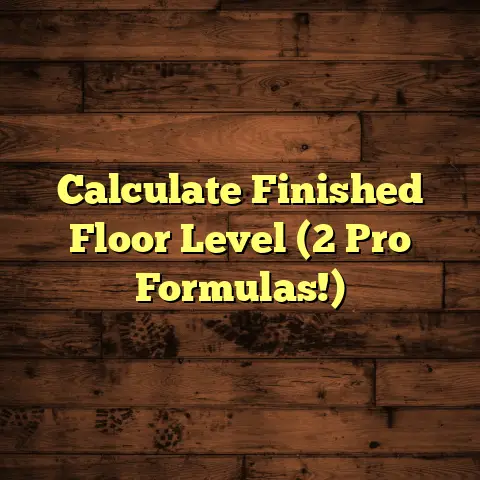How To Calculate Floor For Tiles? (Explained)
Starting off on the right foot as a flooring contractor can make all the difference, and I learned that the hard way. One of my early projects involved a small bathroom remodel, and I made a classic mistake: I didn’t take the time to accurately measure the space before ordering tiles. I thought I could save time by estimating the dimensions instead of pulling out the tape measure. This led to an over-order of tiles, which not only weighed down my budget but also caused delays in the project timeline. From that experience, I realized that accurate calculations are essential for any tile flooring project, no matter how small or large.
Understanding Why Accurate Measurements Matter
Accurate measurements are crucial when working with tiles. The last thing you want is to run out of tiles mid-project or, worse, order too many and have them sit around taking up space (and costing money). As someone who’s spent years in this industry, I can tell you that precision pays off—not just in time and money, but in quality as well.
Step-by-Step Guide to Calculating Floor Area for Tiles
Let’s delve deeper into how to effectively calculate the floor area for tiles. Once you get the hang of it, you’ll feel confident taking on both small and large projects.
1. Measure the Room
The first step is always to measure the room accurately. Grab a reliable tape measure and jot down the dimensions.
- Length and Width: Measure along the longest walls first. If your kitchen measures 12 feet long and 10 feet wide, your calculation would be: Area=Length×Width=12 ft×10 ft=120 square feet\text{Area} = \text{Length} \times \text{Width} = 12 \text{ ft} \times 10 \text{ ft} = 120 \text{ square feet}
- Height Consideration: While primarily focused on floor area, don’t forget to consider vertical elements such as baseboards or transitions if you’re planning to tile up the walls.
2. Account for Irregular Shapes
Rooms often come with unique shapes that require a more nuanced approach to measuring. For odd-shaped rooms, break them down into smaller sections.
- Example: If your living room has a nook or alcove, measure each section separately and sum them up. Imagine a room shaped like a “T.” Measure the main part of the “T” as one section and the top part as another, then add both areas together.
3. Consider Tile Size
Tile sizes vary widely, from standard 12×12 inches to larger formats like 24×24 inches. Once you have calculated the total area, determine how many tiles will fit based on your chosen size.
- Example: If you’re using 12×12 inch tiles, each tile covers 1 square foot. For a 120 square foot kitchen, you would need 120 tiles.
4. Add Extra Tiles
To account for mistakes and future repairs, always purchase extra tiles. A good rule of thumb is to buy an additional 10% of your total tile count.
- Calculation: Total Tiles Needed=Area+(0.10×Area)=120+(0.10×120)=132 tiles\text{Total Tiles Needed} = \text{Area} + (0.10 \times \text{Area}) = 120 + (0.10 \times 120) = 132 \text{ tiles}
Cost Estimation with FloorTally
After calculating the area and number of tiles needed, the next step is budgeting for your project. This is where tools like FloorTally become invaluable.
I remember a time when I was working on a high-end kitchen renovation. FloorTally helped me quickly pull local pricing data for the tiles my client had chosen. I input the dimensions and tile selections, and it generated a detailed budget that included everything—tiles, grout, labor costs, and waste factors. This level of clarity made it easier to present a financial plan to my clients, which they appreciated greatly.
Installation Tips
Once you’ve got your calculations down, it’s time to think about installation. Getting this part right can make or break your project.
Preparing the Subfloor
Before laying down tiles, ensure that your subfloor is clean and level. I once rushed this step and ended up with uneven tiles that required rework. Use a leveling compound if necessary to create a flat surface.
Layout Planning
Before setting your tiles in place, lay them out to see how they fit together. This dry-fitting process can help identify any cuts that need to be made around edges or fixtures.
- Tip: Start from the center of the room and work your way outwards to ensure symmetry. This method has worked wonders for me in achieving a balanced look.
Common Challenges
As with any trade, flooring installation comes with its own set of challenges.
Waste Management: One of the biggest hurdles I’ve faced is managing waste effectively. Some clients want to keep every leftover tile “just in case,” but I’ve learned that accounting for waste percentages ahead of time using tools like FloorTally helps streamline this process.
Time Management: Another challenge is ensuring you stick to your timeline during installation. Getting everything prepped before starting can make a significant difference in how long the job takes.
Successful Installations
Over the years, I’ve had my share of successful installations that have reinforced my love for this craft. One standout project was a spacious living room that featured large-format tiles. The planning phase involved meticulous calculations, but once we started laying down those beautiful tiles, the end result was breathtaking.
The client was thrilled with their new flooring, which not only enhanced their home’s aesthetic but also increased its value. Experiences like these remind me why I love what I do.
Comparing Tile Options
When selecting tiles for your project, it’s essential to weigh different materials against each other.
- Ceramic vs. Porcelain: In my experience, porcelain is denser and less porous than ceramic, making it ideal for high-moisture areas like bathrooms or kitchens.
- Natural Stone: While natural stone adds an elegant touch, it can be pricier and requires more maintenance than ceramic or porcelain options.
Maintenance Tips
After installation, keeping your tile floor looking great requires routine maintenance.
- Regular Cleaning: Sweep or vacuum regularly to remove dirt and debris.
- Mopping: Use a damp mop with a gentle cleaner specifically designed for your tile type.
- Sealing: For natural stone tiles, sealing them periodically will help protect against stains.
Advanced Calculation Techniques
Now let’s get into some advanced techniques for calculating floor space that can elevate your flooring game.
Using Geometry for Complex Areas
For rooms with complex shapes—like an L-shape or those with alcoves—geometry can simplify your calculations.
- Triangles and Circles: If part of your room is circular or triangular in shape, use formulas:
- Triangle:
- Circle:
Where rr is the radius of the circle.
Using Software Tools
There are several software tools available now that can help automate this process even further. They can take measurements and visualize tile layouts for you.
I’ve used some programs that allow you to input room dimensions digitally, and they generate a visual representation of how the tiles will fit together.
Tips for Efficient Tile Cutting
Sometimes you’ll find yourself needing to cut tiles to fit around corners or edges—here are some tips from my experience:
- Invest in Quality Tools: A good tile cutter makes all the difference. I’ve used both manual cutters and electric wet saws; both have their place depending on the job size.
- Measure Twice, Cut Once: Always double-check your measurements before making any cuts to avoid waste.
- Practice Makes Perfect: If you’re new to cutting tiles, practice on scraps first until you get comfortable with the tool.
Safety Precautions During Installation
Safety should always be a priority when working on any flooring project. Here are some precautions I take:
- Wear Protective Gear: Safety glasses and gloves are non-negotiable.
- Proper Ventilation: If you’re using adhesives or grouts that emit fumes, ensure good ventilation in the area.
- Be Mindful of Lifting Techniques: Tiles can be heavy; use proper lifting techniques to avoid injury.
Troubleshooting Common Issues
Sometimes things don’t go as planned during installation. Here are some common issues and how to troubleshoot them:
Uneven Tiles
If you notice uneven tiles after installation:
- Check Your Subfloor: Uneven subfloors lead to uneven tiles; use self-leveling compounds if necessary.
- Use Spacers: Make sure you’re using spacers between tiles for consistent gaps.
Grout Issues
If your grout appears cracked or discolored:
- Allow Proper Curing Time: Ensure you let grout cure according to manufacturer instructions.
- Use Quality Grout Sealer: Applying sealer can help prevent stains and moisture damage.
Long-Term Care for Tile Floors
After installation, maintaining tile floors keeps them looking their best for years to come:
- Regular Maintenance Schedule: Set up a cleaning schedule that includes sweeping and mopping.
- Address Stains Quickly: Clean spills immediately to avoid stains setting in.
- Inspect Regularly: Check grout lines periodically for wear or damage.
Final Thoughts on Calculating Floor Area for Tiles
Calculating floor area for tiles doesn’t have to be overwhelming. With careful measurements and planning—combined with tools like FloorTally for cost estimation—you can set yourself up for success in any flooring project.
Always account for extra materials, consider your installation strategy wisely, and don’t hesitate to reach out for help if needed. Learning from both successes and challenges has helped me refine my approach over the years, and I hope these insights are helpful for you too!
With practice and attention to detail, you’ll find yourself mastering tile installations in no time!





